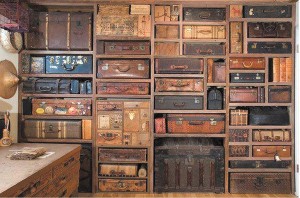Antique steamer trunks, vanity cases and even that old Samsonite suitcase you carried off to college in 1987 are at the top of the most wanted collectibles list for the summer of 2017. Collectible vintage luggage is sought by repurposers who turn it into furniture, interior designers who stack it high for storage and effect and Millennials who are selecting it as their luggage of choice for travel.
The most valuable pieces of luggage to find are the rare vanity cases and steamer trunks from the late 1800s and the first quarter of the 20th Century. Many of these pieces were owned by the affluent who indulged themselves with overseas travel on the luxury ships of the day. They were expensive when originally purchased and you will, most likely, have to lay down some serious cash for them today.
Steamer trunks (also known as travel trunks or cabin trunks), when opened, stood on one end to reveal storage for hanging garments on one side and drawers on the other. Some will come with trays, mirrors or straps to hold shoes. Watch for trunks with monograms and stickers from exotic places. They not only tell the history of the piece, they can also make them more valuable.
Vanity cases were used to carry personal care items on long trips and, unlike larger luggage, were often kept with the traveler. These cases were quite beautiful and well made with compartments for makeup, perfume, hair brushes and jewelry. For the traveling man there were small bags called grooming kits which held sundries, brushes and shaving needs. Newer examples of these will be fabric, but fine older ones are usually leather or canvass.
As we entered the 1920s travel by both rail and automobile allowed for the common man to travel for travel’s sake. The steamer trunks of the past were now far too bulky to be practical and many resorted to carrying their belongings in small cardboard boxes or crates. To answer the needs of the traveler, luggage manufacturers began offering “suit cases” These lightweight trunks were made by stretching leather, wicker or rubbery cloth over a steel frame. They were a move forward from the weight of the steamer trunk, but still quite heavy by today’s standards.
The greatest strides toward modern luggage came in the 1930s led by two main manufacturers, whose names you will most likely recognize. The American Luggage Works of Providence, Rhode Island introduced the first rounded corner, plywood frame suitcases in 1932 and dubbed them their American Tourister line. They came in four styles, four colors and eight different sizes. A second name to watch for is Samsonite. Developed in 1939 by Jessee Shwayder, and named after Samson, the strongest man in the Bible, Samsonite luggage from this era featured a tapered style and was covered in a tough vulcanized fabric. Throughout the 20th Century both Samsonite and American Tourister provided quality luggage for the middle class. As a result, many of their pieces of luggage are found today at auctions, estate sales and online through Etsy and eBay.
Before you purchase a piece of vintage or antique luggage there are several points to consider. Externally, beware of missing handles or hardware, broken stitching, locks that don’t work or are missing and cracked leather. Internally, check for rips and stains, broken mirrors, missing drawers and odors. Watch for signs that the luggage has been repaired. While this is not necessarily a deal breaker, it is grounds for haggling on the price. Until next time….Linda
Linda Kennett is a professional liquidation consultant specializing in down-sizing for seniors and the liquidation of estates and may be reached at 317-258-7835 or lkennett@indy.rr.com



